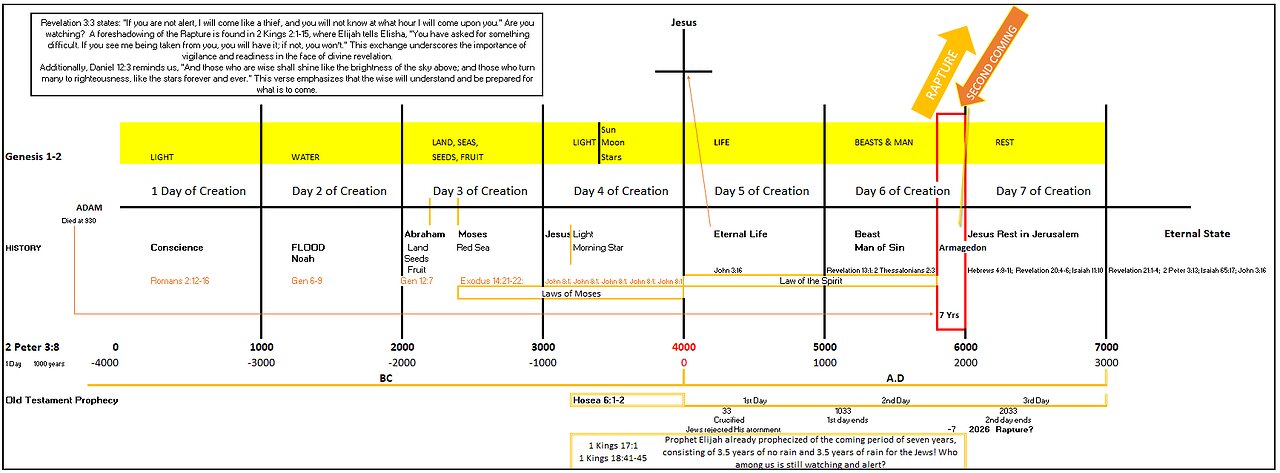Premium Only Content

Ibi Nibyo Bitwereka Neza ko Itorero Rigiye Kuzamurwa
Aligning Prophecy with Historical Patterns
Scriptural chronology often uses the concept of a day representing a thousand years (2 Peter 3:8). God created the world in six days and rested on the seventh, not because He was tired—for He could have created everything in mere seconds—but because He established an intentional order that foreshadowed His divine plans. Each day of creation reflects God's design for human history. For example, on the first day, He created light, symbolizing the Spirit or conscience given to Adam. On the second day, He created water, foreshadowing the flood in the second millennium. On the third day, God created land, seas, and seeds, paralleling the third millennium when He promised land to Abraham and his descendants and parted the sea through Moses. On the fourth day, He created the sun, moon, and stars, all pointing to Jesus, who was born around 4,000 years into human history. On the fifth day, God created life, representing the eternal life Jesus brought through His crucifixion.
On the sixth day, He created beasts and humans, symbolizing the coming man of sin or beast of Revelation, expected in this sixth millennium. This man of sin will be the leading figure during the Tribulation, as described in 2 Thessalonians 2:3-4, where he is depicted as exalting himself and opposing everything that is of God. This intricate design is not coincidence but reflects God's intelligent plan. The Scripture highlights that this period of seven years, often referred to as the Tribulation, is divided into two phases of 3.5 years each (Daniel 9:27; Revelation 11:2-3). Elijah's prophecy of three and a half years of drought (1 Kings 17:1), symbolizing the absence of the Holy Spirit, is followed by three and a half years of rain (1 Kings 18:41-45), representing the Lord's turning back to the Jews and giving them the Holy Spirit. This prophetic parallel underscores the spiritual significance of this period in understanding the culmination of God's redemptive plan for humanity, as it aligns with the judgment and restoration described in the book of Revelation. However, the Rapture is believed to precede this period, as it serves to protect the Church from the wrath of God that will be poured out during the Tribulation (1 Thessalonians 1:10; Revelation 3:10).
Finally, the seventh day—corresponding to the seventh millennium—will usher in God's Kingdom, where He will rest with His people, fulfilling His promises of restoration and peace (Genesis 2:2-3; Revelation 20:4-6).
Could this be the moment when the Rapture and subsequent events are set in motion? The prophecy of Hosea 6:1-3 also resonates profoundly with this timeline: "Come, let us return to the Lord. For he has torn us, and he will heal us; he has wounded us, and he will bind up our wounds. After two days he will revive us; on the third day he will raise us up, that we may live before him" (Hosea 6:1-2). Verse 3 makes it clear that this context refers to the second coming of Jesus and the millennium: “"Let’s strive to know the Lord. His appearance is as sure as the dawn. He will come to us like the rain, like the spring showers that water the land.” Jesus was crucified at age 33, and the Jewish people denied His atonement. Thus, "after two days" would imply the year 2033, and "on the third day" marks the beginning of Jesus' millennial reign. If the millennium begins in 2033, subtracting the seven years of Tribulation suggests that this period would start in 2026. This raises a sobering question: could the Rapture happen anytime between 2025 and 2026? If you are not watching, you will not know!
Learn more: https://learn.openchristian.education/blog/sangwa/the-rapture-is-closer-than-we-think
-
 2:40:15
2:40:15
Barry Cunningham
4 hours agoPRESIDENT TRUMP SIGNS NEW EXECUTIVE ORDERS AND THE EVENING NEWS!
15.6K10 -
 2:49:55
2:49:55
TimcastIRL
4 hours agoGOP Office TORCHED, Terror Suspected, Elon Says ARREST Dem Funders w/Winston Marshall | Timcast IRL
169K75 -
 1:39:42
1:39:42
Glenn Greenwald
6 hours agoMajor Escalation in Attempts to Purge U.S. Universities of Israel Critics; Who are the Israel Groups Providing Lists to the U.S. Government to Deport & Punish? | SYSTEM UPDATE #431
160K140 -
 LIVE
LIVE
SpartanTheDogg
10 hours agoPro Halo Player
482 watching -
 1:08:55
1:08:55
Donald Trump Jr.
10 hours agoGlobalist Panic & Populist Prosperity, Live with Natalie Winters & Alex Epstein | Triggered Ep229
151K97 -
 1:37:15
1:37:15
CocktailsConsoles
2 hours agoBE PART OF THE GAME!!| Death Road to Canada | Cocktails & Consoles Livestream
16.9K -
 1:04:29
1:04:29
BonginoReport
8 hours agoFDA Vax Pusher Needs to Look in the Mirror - Nightly Scroll w/ Hayley (Ep.16) - 03/31/2025
114K78 -
 3:27:31
3:27:31
SquallRush
1 day agoBrawlhalla Mondays!
20.8K -
 LIVE
LIVE
Misfit Electronic Gaming
7 hours ago $1.46 earned"LIVE" It's So Monday So lets Perk it up. Lets Earn Gears"Party Animals" & R.E.P.O. Who will join me????
307 watching -
 54:13
54:13
Sarah Westall
7 hours agoCIA Disclosures: Ark of the Convenient, the Pyramid Code, Ley Lines & Earth’s Energy w/ Jason Shurka
84.9K23